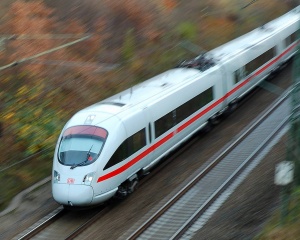Deutsche Bahn outlines international plans

Deutsche Bahn has outlined plans to offer services between London, Frankfurt and Amsterdam by 2013 using the Channel Tunnel.
As an ICE3 train arrived at London St Pancras for a demonstration today, the German national rail operator said it would also offer services to Brussels, Cologne and Rotterdam.
In order to proceed, Deutsche Bahn must secure safety approval from Channel Tunnel safety authorities, but is confident of doing so ahead of the proposed launch.
Eurostar is presently the only passenger service operating in the Channel Tunnel. However, Eurotunnel – which operates the facility – has confirmed it is presently running at just half of its maximum capacity.
Deutsche Bahn wants to offer passengers direct services from London three times a day. All trains would depart from London before splitting at Brussels.
With trains capable of over 200mph, the journey to Amsterdam would take around four hours, with Frankfurt around five hours away.
Safety Issues
The proposed new services would use the Siemens ICE3 inter-city express trains, presently on display at St Pancras. Deutsche Bahn has been carrying out safety tests this week to assess the feasibility of the proposals.
An ICE3 train operated by Deutsche Bahn entered the Channel Tunnel for the first time on October 13th, while an in-tunnel evacuation took place on Sunday.
Deutsche Bahn needs approval from the Channel Tunnel Intergovernmental Commission to operate services in the tunnel – with concerns over access to service tunnels paramount.
Passages to the service tunnel are placed every 375 metres in he Channel Tunnel, which means a 400 metre Eurostar train can position itself to allow passengers to get off at either end and immediately access the escape route.
The ICE 3 trains are each 200m long and two of them would be joined together for the journey through the tunnel.
Power Generation
Concerns have also been raised over rules which only allow for the train’s traction to come from dedicated power cars at either end.
This is the set-up presently used by Eurostar. However, the operator has recently ordered a fleet of new e3202 trains, which have distributed power sources similar to employed by ICE3 trains.

